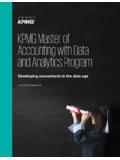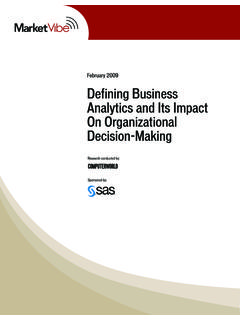Transcription of Big Data, Analytics and the Path From Insights to …
1 Big data , Analytics and the path From Insights to ValueWINTER 2011 NUMBER 52205 Steve LaValle, Eric Lesser, Rebecca Shockley, Michael S. Hopkins and Nina KruschwitzWINTER 2011 MIT SLOAN MANAGEMENT REVIEW 21In 2002, Greater Atlanta s Gwinnett County public school system, not unlike big public school systems everywhere, had a problem. Student perfor-mance by any metric was dropping, and graduation rates for at-risk kids and underprivileged teenagers especially were in decline. Nothing the educators attempted was reversing the the school like all enterprises of its size, whether commercial or institutional increasingly had data . And Gwinnett County started to use , in suburban Atlanta, Georgia, is the 14th largest school system in the United States, has 23,000 employees and transports more people every school day than locally based carrier, Delta Air Lines.
2 All that activ-ity generates information, more and more of it captured digitally. And in 2002, as the school system s leaders continued seeking fresh educational solutions, they began to explore how Analytics could help how all that information could be investigated for patterns, relationships, dependencies, predictors. The question: What as-pects of an educationally at-risk student s performance most accurately predicted whether or not he or she would eventually graduate? Where was the leverage that could change that student s likelihood of success?The Analytics -driven answer: Algebra I. The data proved that for the most challenged cohort of students noth-ing was a more powerful predictor of graduation than the successful completion of Algebra I (in this system, Big data , Analytics and the path From Insights to ValueHow the smartest organizations are embedding Analytics to transform information into insight and then action.)
3 Findings and recommendations from the first annual New Intelligent Enterprise Global Executive LEADING QUESTIONHow are organizations using Analytics to gain insight and guide action?FINDINGS Top-performing organizations are twice as likely to apply Analytics to activities. The biggest chal-lenges in adopting Analytics are mana-gerial and cultural. Visualizing data differently will be-come increasingly of the best-performing retailers are using Analytics not just for finance and operational activities, but to boost competitive advantage on everything from displays, to marketing, customer service and customer experience NEW INTELLIGENT ENTERPRISECOURTESY OF BEST BUYFROM THE EDITOR22 MIT SLOAN MANAGEMENT REVIEW WINTER NEW INTELLIGENT ENTERPRISE usually a ninth- or 10th-grade course). But how could you get kids who had historically struggled at math who had failed prior courses in earlier years to improve enough that they could pass Algebra I?
4 What did the data advise about that?The answer was astonishing. What turned out to be the best predictor of Algebra I success for students who had failed previous math courses? Success at eighth-grade creative discovery in hand, Gwinnett poured attention and resources into helping students succeed in eighth-grade cre-ative writing classes. The result? As writing course success rates improved, so did Algebra I success rates and, eventually, so did high school graduation rates. The seemingly irreversible trend was reversed. And in the fall of 2010, Gwinnett won the prestigious Broad Prize, which honors the school districts that demonstrate the strongest student achievement and improvement while narrowing achievement gaps between income and ethnic groups. Analytics had turned information into insight, and insight into action. And action had produced a landmark , so Analytics can change young lives.
5 That s one happy conclusion to draw from Gwinnett s story. But there were uncomfortable discoveries as well. Gwinnett s data revealed, for instance, that some time-honored approaches to edu-cation were not only ineffective but actually counterproductive a message that wasn t warmly received by everyone. In fact, Gwinnett s overall experience illustrates a great deal about what organizations can expect as they embrace data -driven management and Analytics . Some long-held beliefs will be proven wrongheaded. Some new Insights will yield extraordinary results. And the evidence suggests organizations that effectively adopt data -driven manage-ment are likely to become leading performers in their industries. (For more about Gwinnett, look for an interview with Gwinnett CIO Scott Futrell on , coming in January.)All of those observations square with findings from the 2010 New Intelligent Enterprise Global Executive Study and Research Project, summarized in the pages that follow.
6 The study, by MIT Sloan Management Review in collaboration with the IBM Institute for Business Value, attempts to understand better how all organizations are attempting to capital-ize on information and apply Analytics today and in the well-documented data deluge continues to deepen. (Factoid: In 2009 alone, humans produced more data than in all prior years combined.) And our study reveals that many executives continue to feel overwhelmed (60% say they have more information than they can effectively use ). But the study also shows that the smartest organizations are already capitalizing on increased information richness and Analytics to gain competitive : A critical competitive gap is growing. The top-performing companies are the ones that are most data driven. And based on Insights from our survey, case studies and interviews with experts, it s possible to describe an emerging five-point methodology for successfully implementing Analytics -driven management and rapidly creating value as leading businesses are already managing to s how the best organizations are transforming themselves not only to be smarter but to act smarter.
7 And to win. Michael S. Hopkins, Editor-in-ChiefIN EVERY INDUSTRY, in every part of the world, senior leaders wonder whether they are get-ting full value from the massive amounts of information they already have within their organi-zations. New technologies are collecting more data than ever before, yet many organizations are still looking for better ways to obtain value from their data and compete in the marketplace. Their ques-tions about how best to achieve value persist. Are competitors obtaining sharper, more timely Insights ? Are they able to regain market advantage, ne-glected while focusing on expenses during the past two years? Are they correctly interpreting new signals from the global economy and adequately assessing the impact on their customers and partners? Knowing what happened and why it happened are no longer adequate. Organizations need to know what is hap-pening now, what is likely to happen next and what actions should be taken to get the optimal results.
8 To help organizations understand the opportu-nity of information and advanced Analytics , MIT Sloan Management Review partnered with the IBM Institute for Business Value to conduct a survey of nearly 3,000 executives, managers and analysts work-Special Report: Analytics and the New path to Value BY STEVE LAVALLE, ERIC LESSER, REBECCA SHOCKLEY, MICHAEL S. HOPKINS AND NINA KRUSCHWITZABOUT THE RESEARCH To understand the chal-lenges and opportunities associated with the use of business Analytics , MIT Sloan Management Re-view, in collaboration with the IBM Institute for Busi-ness Value, conducted a survey of more than 3,000 business executives, man-agers and analysts from organizations located around the world. The survey captured Insights from individuals in 108 countries and more than 30 industries and involved or-ganizations from a variety of sizes. The sample was drawn from a number of different sources, including MIT alumni and MIT Sloan Management Review sub-scribers, IBM clients and other interested also interviewed academic experts and sub-ject matter experts from a number of industries and disciplines to understand the practical issues facing organizations today.
9 Their Insights contributed to a richer understanding of the data and the development of recommendations that respond to strategic and tactical questions that senior executives address as they operationalize Analytics within their orga-nizations. We also drew upon a number of IBM case studies to explore fur-ther how organizations are leveraging business analyt-ics and illuminate how real organizations are putting our recommendations into action in different organiza-tional 2011 MIT SLOAN MANAGEMENT REVIEW 23ing across more than 30 industries and 100 countries. (See About the Research. ) Among our key findings: Top-performing orga-nizations use Analytics five times more than lower performers. (See Analytics Trumps Intuition. ) Overall, our survey found a widespread belief that Analytics offers value. Half of our respondents said that improvement of information and Analytics was a top priority in their organizations.
10 And more than one in five said they were under intense or signifi-cant pressure to adopt advanced information and Analytics source of the pressure is not hard to ascer-tain. Six out of 10 respondents cited innovating to achieve competitive differentiation as a top business challenge. The same percentage also agreed that their organization has more data than it can use ef-fectively. Organizational leaders want Analytics to exploit their growing data and computational power to get smart, and get innovative, in ways they never could before. Senior executives now want businesses run on data -driven decisions. They want scenarios and simulations that provide immediate guidance on the best actions to take when disruptions occur disruptions ranging from unexpected competitors or an earthquake in a supply zone to a customer signaling a desire to switch providers.



